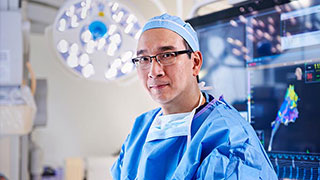Leaders in New Treatment Approach
Pancoast cancer – also known as superior sulcus cancer or tumor – is an uncommon cancer that arises in the very top part of the lung and invades the uppermost part of the chest cavity.
Most Pancoast tumors are non-small cell lung cancers. Evaluation and treatment is particularly challenging because these cancers are near major blood vessels and nerves.
UT Southwestern specialized chest (thoracic) cancer physicians are experts in diagnosing and treating Pancoast tumors. Our institution is recognized as a pioneer in the treatment of Pancoast cancer, thanks largely to research conducted by thoracic surgeons Robert Shaw, M.D., and Donald Paulson, M.D., in the 1950s and 1960s.
These physician-scientists found that a three-pronged treatment approach – chemotherapy, radiation therapy, and surgery – led to the best outcomes for patients.
Causes and Symptoms of Pancoast Cancer
The causes and risk factors for Pancoast cancer are similar to those of other lung cancers:
- Smoking
- Exposure to secondary smoke
- Long-term asbestos exposure
- Exposure to industrial elements such as gold or nickel
The symptoms of Pancoast cancer differ from symptoms that accompany cancer in other parts of the lung. Symptoms of Pancoast cancer are often referred to as Pancoast syndrome and include pain in the shoulder, inner side of the arm, and hand.
Diagnosis
To diagnose a Pancoast tumor, a doctor will conduct a physical examination and order some tests, such as the following imaging tests:
- Chest X-ray: This type of imaging help visualize abnormalities in the lungs.
- Contrast-enhanced or multidetector computed tomography (CT) scan: CT technology helps physicians visualize the location and extent of Pancoast cancer.
- Magnetic resonance imaging (MRI): MRI helps physicians identify suspicious areas that could indicate Pancoast cancer and learn if, and how far, it has spread.
- Positron emission tomography (PET): Cancer cells absorb large amounts of radioactive sugar used in this technique, and a special camera creates images of that radioactivity, enabling physicians to identify Pancoast tumor cells.
- Endoscopic ultrasonography: This technology maps sound waves to help doctors visualize the precise location of the Pancoast tumor.
Additional testing might also include a tissue sample (biopsy) of the tumor to determine the presence of Pancoast cancer.
Treatment for Pancoast Cancer
Because of its location, Pancoast cancer can be especially challenging to treat. Treatment options depend on the cancer’s precise location and stage; the patient’s overall health, goals, and preferences; and other factors.
UT Southwestern’s thoracic cancer specialists might consider these therapies for treating a Pancoast tumor:
- Treatment with medication: Chemotherapy drugs, taken orally or intravenously, can be used to target and kill cancer cells in the pericardium. Chemotherapy might also be used in conjunction with radiation therapy (chemoradiation) to treat Pancoast cancer.
- Radiation therapy: This treatment uses high-energy radiation, such as X-rays, to destroy cancer cells in the lungs. UT Southwestern is a recognized leader in the development and use of cancer-fighting radiation therapies.
- Surgery: Highly precise surgery to remove cancerous tissue can be used in some early-stage cases of Pancoast cancer.
Support Services
UT Southwestern offers support services for patients and their families to help them handle every situation they experience during cancer treatment and after. These services include nutrition counseling, physical therapy and rehabilitation, support groups, and more.
Clinical Trials
Depending on the cause and extent of Pancoast tumor, some patients might be eligible to participate in clinical trials of new treatments for the disease.
UT Southwestern conducts clinical trials aimed at improving the care and outcomes of patients with Pancoast tumors. Patients should speak with their physician about joining a clinical trial.





